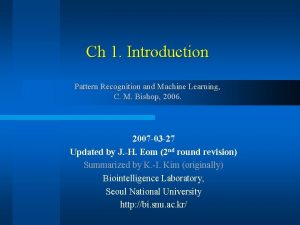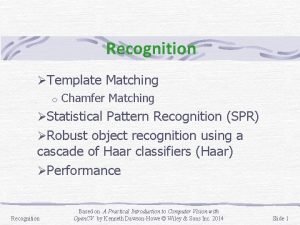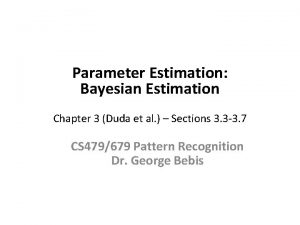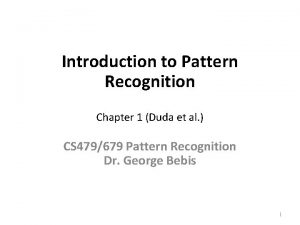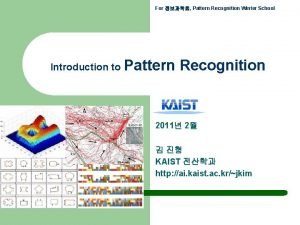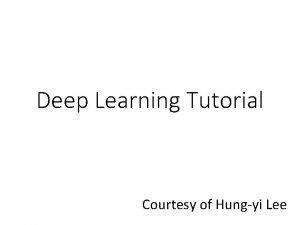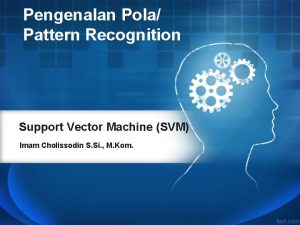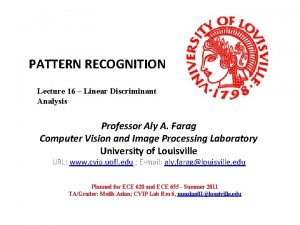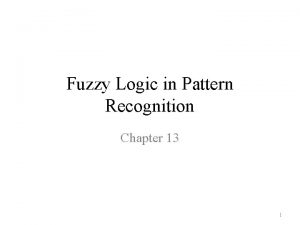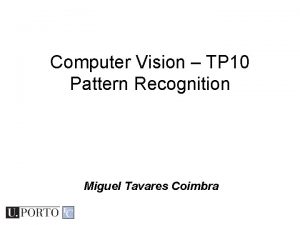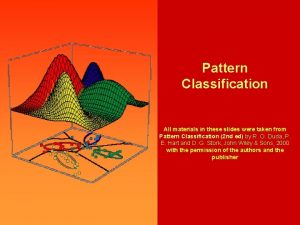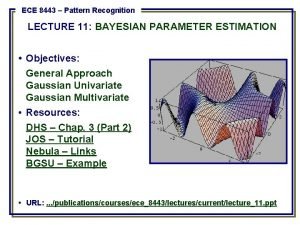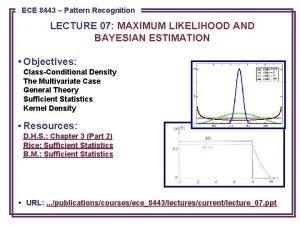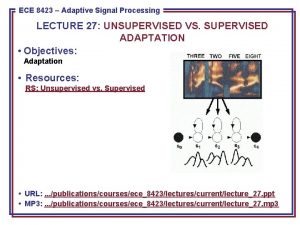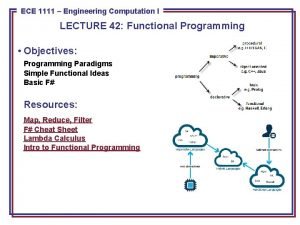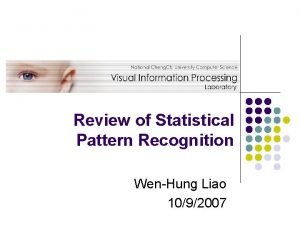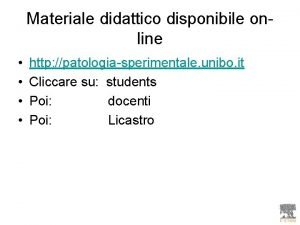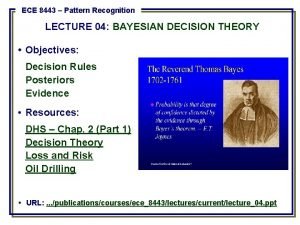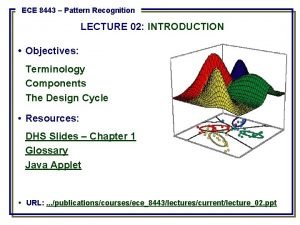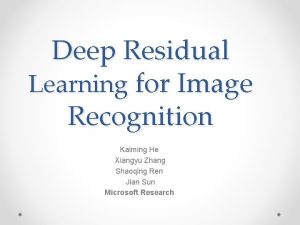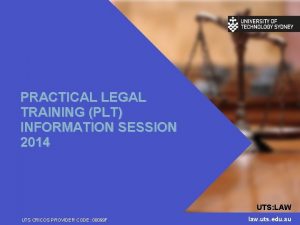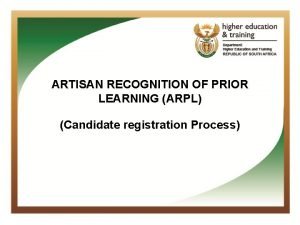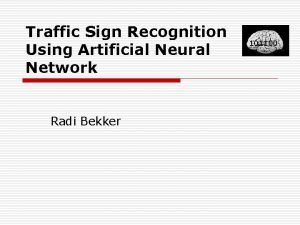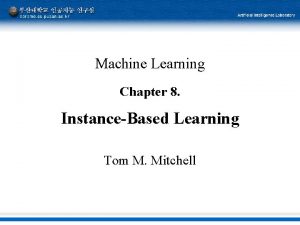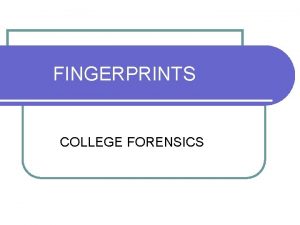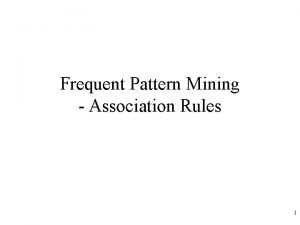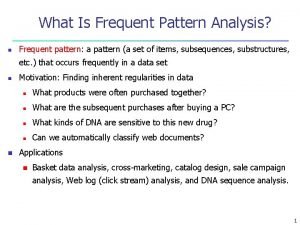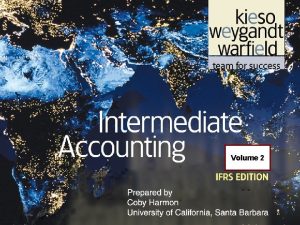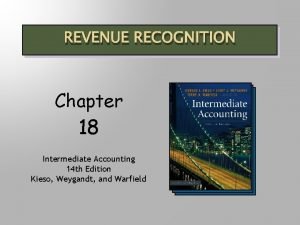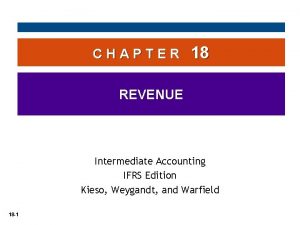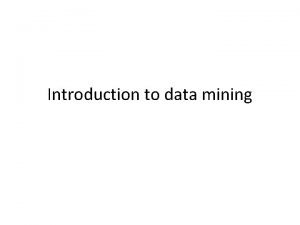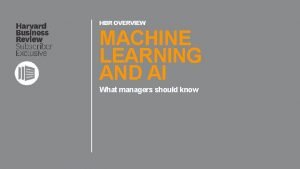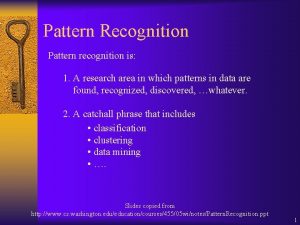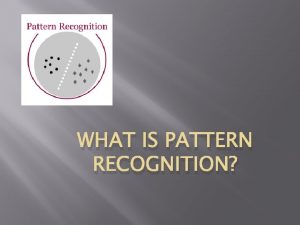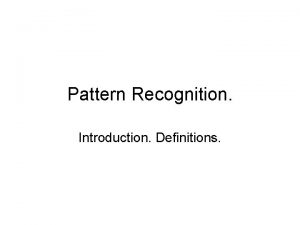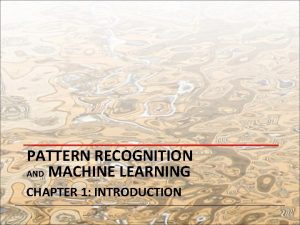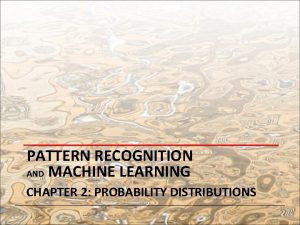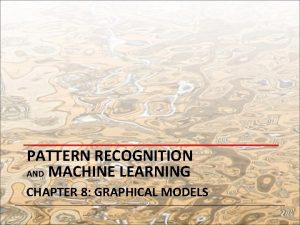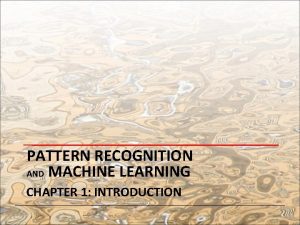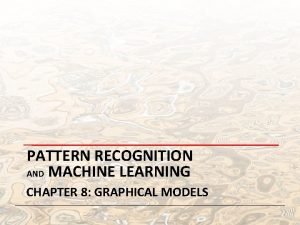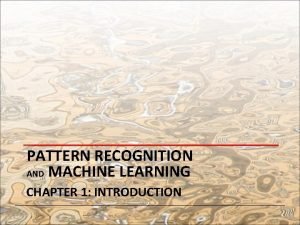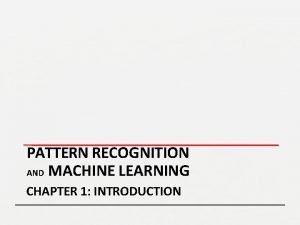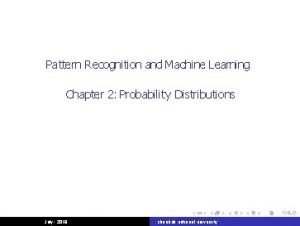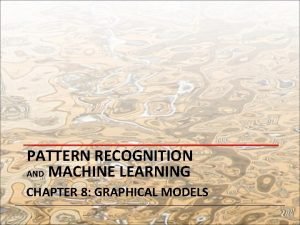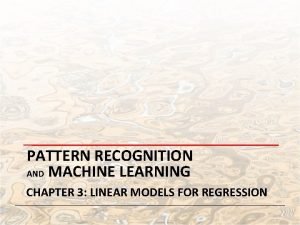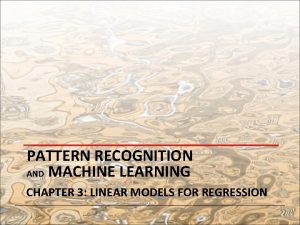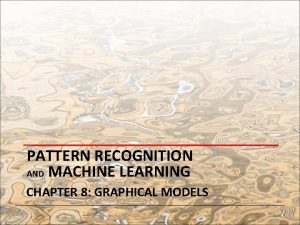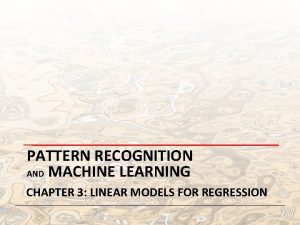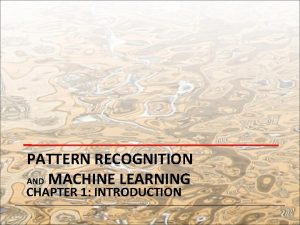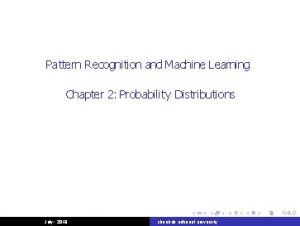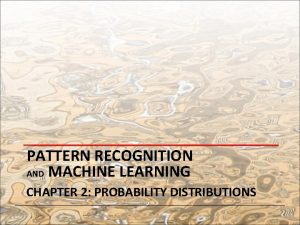Week 3 PATTERN RECOGNITION AND MACHINE LEARNING CHAPTER































































- Slides: 63

Week 3 PATTERN RECOGNITION AND MACHINE LEARNING CHAPTER 2: PROBABILITY DISTRIBUTIONS

Bayesian Inference for the Gaussian (1) Assume ¾ 2 is known. Given i. i. d. data , the likelihood function for ¹ is given by This has a Gaussian shape as a function of ¹ (but it is not a distribution over ¹).

Bayesian Inference for the Gaussian (2) Combined with a Gaussian prior over ¹, this gives the posterior Let, the posterior be

Bayesian Inference for the Gaussian (3) Then, Note:

Bayesian Inference for Gaussian (4) Example: and 10. for N = 0, 1, 2

Sequential Estimation of Parameters using Bayesian Inference for the Gaussian The posterior obtained after observing N { 1 data points becomes the prior when we observe the N th data point.

Sequential Estimation using MLE of Gaussian Contribution of the N th data point, x. N correction given x. N correction weight old estimate

Sequential Estimation using The Robbins-Monro Algorithm Consider the log likelihood function averaged over N as N goes to infinity =0 Goal: Solve this equation sequentially for µN given µN -1

The Robbins-Monro Algorithm (1) Consider µ and z governed by p(z, µ) and define the regression function Seek µ? such that f(µ? ) = 0.

The Robbins-Monro Algorithm (2) Assume we are given samples from p(z, µ), one at the time.

The Robbins-Monro Algorithm (3) Successive estimates of µ? are then given by Conditions on a. N for convergence :

Robbins-Monro for Maximum Likelihood (4) Compare to as a regression function, finding its root is equivalent to finding the maximum likelihood solution µML. Thus

Robbins-Monro for Maximum Likelihood (5) Example: estimate the mean of a Gaussian. The distribution of z is Gaussian with mean ¹ { ¹ML. For the Robbins-Monro update equation, a. N = ¾ 2=N.

Bayesian Inference for the Gaussian (6) Now assume ¹ is known. The likelihood function for ¸ = 1/¾ 2 is given by This has a Gamma shape as a function of ¸.

Bayesian Inference for the Gaussian (7) The Gamma distribution

Bayesian Inference for the Gaussian (8) Now we combine a Gamma prior, , with the likelihood function for ¸ to obtain for posterior with

Bayesian Inference for the Gaussian (9) If both ¹ and ¸ are unknown, the joint likelihood function is given by We need a conjugate prior with the same functional dependence on ¹ and ¸.

Bayesian Inference for the Gaussian (10) The Gaussian-gamma distribution • Quadratic in ¹. • Linear in ¸. • Gamma distribution over ¸. • Independent of ¹.

Bayesian Inference for the Gaussian (11) The Gaussian-gamma distribution

Bayesian Inference for the Gaussian (12) Multivariate conjugate priors • ¹ unknown, ¤ known: p(¹) Gaussian. • ¤ unknown, ¹ known: p(¤) Wishart, • ¤ and ¹ unknown: p(¹, ¤) Gaussian-Wishart,

A Robust Distribution as an Alternative to Gaussian: Student’s t-Distribution by Gosset where : Degree of freedom Infinite mixture of Gaussians.

Student’s t-Distribution

Student’s t-Distribution Robustness to outliers: Gaussian vs t-distribution.

Student’s t-Distribution The D-variate case: where Properties: .

Another Interesting Distribution for Periodic rv’s- Von Mises Distribution • Example: Temperature of a season in a day, … • We require

θn: periodic variable as twodimensional vectors xn living around the unit circle.

von Mises Distribution (1) This requirement is satisfied by where is the 0 th order modified Bessel function of the 1 st kind.

von Mises Distribution (4)

Maximum Likelihood for von Mises Given a data set, is given by , the log likelihood function Maximizing with respect to µ 0 we directly obtain Similarly, maximizing with respect to m we get which can be solved numerically for m. ML.

Mixtures of Gaussians (1) Old Faithful data set Single Gaussian Mixture of two Gaussians

Mixtures of Gaussians (2) Combine simple models into a complex model: Component Mixing coefficient K=3

Mixtures of Gaussians (3)

Mixtures of Gaussians (4) Determining parameters ¹, §, and ¼ using maximum log likelihood Log of a sum; no closed form maximum. Solution: use standard, iterative, numeric optimization methods or the expectation maximization algorithm (Chapter 9).

EXPONENTİALS : 1. Gaussian 2. Bernoulli 3. Binomial 4. Beta 5. Gamma 6. Multinomial 7. Dirichlet 8. Gaussian Gama 9. Student 10. Von Mises

The Exponential Family (1) where ´ is the natural parameter and so g(´) can be interpreted as a normalization coefficient.

Bernoulli: and so Logistic sigmoid

The Bernoulli distribution where

The Multinomial: where, , and NOTE: The ´ k parameters are not independent since the corresponding ¹k must satisfy

Let . This leads to and Softmax Here the ´ k parameters are independent. Note that and

The Multinomial distribution can then be written as

The Gaussian Distribution where

MLE for the Exponential Family

ML for the Exponential Family (2) Give a data set, function is given by , the likelihood Take log, then take derivative Sufficient statistic

Conjugate prior of likelihood İs Combining with the likelihood function, we get Prior corresponds to º pseudo-observations with value .

Noninformative Priors (1) With little or no information available a-priori, we might choose a non-informative prior. • ¸ discrete, K-nomial : • ¸ 2[a, b] real and bounded: • ¸ real and unbounded: improper! A constant prior may no longer be constant after a change of variable; consider p(¸) constant and ¸=´ 2:

Noninformative Priors (2) Translation invariant priors. Consider For a corresponding prior over ¹, we have for any A and B. Thus p(¹) = p(¹ { c) and p(¹) must be constant.

Noninformative Priors (3) Example: The mean of a Gaussian, ¹ ; the conjugate prior is also a Gaussian, As , this will become constant over ¹.

Noninformative Priors (4) Scale invariant priors. Consider and make the change of variable For a corresponding prior over ¾, we have for any A and B. Thus p(¾) 1/¾ and so this prior is improper too. Note that this corresponds to p(ln ¾) being constant.

Noninformative Priors (5) Example: For the variance of a Gaussian, ¾ 2, we have If ¸ = 1/¾ 2 and p(¾) / 1/¾ , then p(¸) / 1/ ¸. We know that the conjugate distribution for ¸ is the Gamma distribution, A noninformative prior is obtained when a 0 = 0 and b 0 = 0.

Nonparametric Methods (1) Parametric distribution models are restricted to specific forms, which may not always be suitable; for example, consider modelling a multimodal distribution with a single, unimodal model. Nonparametric approaches make few assumptions about the overall shape of the distribution being modelled.

Nonparametric Methods (2) Histogram methods partition the data space into distinct bins with widths ¢i and count the number of observations, ni, in each bin. • Often, the same width is used for all bins, ¢i = ¢. • ¢ acts as a smoothing parameter. • In a D-dimensional space, using M bins in each dimension will require MD bins!

Nonparametric Methods (3) Assume observations drawn from a density p(x) and consider a small region R containing x such that If the volume of , V, is sufficiently small, p(x) is approximately constant over R and The probability that K out of N observations lie inside is Bin(K/ N, P ) and if N is large Thus V small, yet K>0, therefore N large?

For to be the true density, we need 1. V should be small 2. K skould be large 3. K/N should be small Q: How do we select V?

Two Approaches 1. Kernel Method Fix V and count K at each V 2. K-NN Method Fix K and grow V until it closes K samples

1. Kernel Density Estimation fix V, estimate K from the data. Let V= h. D be a hypercube centred on x and define the kernel function (Parzen window). Define

Uniform Kernel k(u)= 1 for abs(u)≤ 1/2 0 otherwise It follows that and hence

Kernel is just an interpolation function

Gaussian Kernel To avoid discontinuities in p(x), use a smooth kernel, e. g. a Gaussian Any kernel such that h acts as a smoother. will work.

2. Nearest Neighbour Density Estimation: fix K, estimate V from the data. Consider a hypersphere centred on x and let it grow to a volume, V ? , that includes K of the given N data points. Then K acts as a smoother.

2. Nearest Neighbour Density Estimation: Nonparametric models (not histograms) requires storing and computing with the entire data set. Parametric models, once fitted, are much more efficient in terms of storage and computation.

K-Nearest-Neighbours for Classification (1) Given a data set with Nk data points from class Ck and , we have and correspondingly Since , Bayes’ theorem gives

K-Nearest-Neighbours for Classification (2) K=3 K=1

K-Nearest-Neighbours for Classification (3) • K acts as a smother • For , the error rate of the 1 -nearest-neighbour classifier is never more than twice the optimal error (obtained from the true conditional class distributions).
 Cm bishop pattern recognition and machine learning
Cm bishop pattern recognition and machine learning Inductive and analytical learning
Inductive and analytical learning Focl in machine learning
Focl in machine learning Eager learning examples
Eager learning examples Week by week plans for documenting children's development
Week by week plans for documenting children's development Template matching pattern recognition
Template matching pattern recognition Bayesian parameter estimation in pattern recognition
Bayesian parameter estimation in pattern recognition Vyr737
Vyr737 Fuzzy classification in pattern recognition
Fuzzy classification in pattern recognition Design cycle of pattern recognition
Design cycle of pattern recognition Pattern recognition
Pattern recognition Pattern recognition lab
Pattern recognition lab Pattern recognition clinical reasoning
Pattern recognition clinical reasoning Contoh pattern recognition
Contoh pattern recognition Discriminant function in pattern recognition
Discriminant function in pattern recognition Fuzzy logic in pattern recognition
Fuzzy logic in pattern recognition Pattern recognition
Pattern recognition Flickr
Flickr Wax pattern fabrication
Wax pattern fabrication Contoh template matching
Contoh template matching Pattern recognition slides
Pattern recognition slides Picture recognition
Picture recognition Pattern recognition
Pattern recognition Bayesian parameter estimation in pattern recognition
Bayesian parameter estimation in pattern recognition Pattern recognition
Pattern recognition Pattern recognition
Pattern recognition Pattern recognition
Pattern recognition Statistical pattern recognition a review
Statistical pattern recognition a review Patologia sperimentale unibo
Patologia sperimentale unibo Bayesian decision theory in pattern recognition
Bayesian decision theory in pattern recognition Objectives of pattern recognition
Objectives of pattern recognition Concept learning task in machine learning
Concept learning task in machine learning Analytical learning in machine learning
Analytical learning in machine learning Pac learning model in machine learning
Pac learning model in machine learning Pac learning model in machine learning
Pac learning model in machine learning Instance based learning in machine learning
Instance based learning in machine learning Inductive learning machine learning
Inductive learning machine learning First order rule learning in machine learning
First order rule learning in machine learning Deep learning vs machine learning
Deep learning vs machine learning He kaiming
He kaiming Deep learning speech recognition
Deep learning speech recognition Recognition of prior learning uts
Recognition of prior learning uts Nadsc registration
Nadsc registration Traffic sign recognition deep learning
Traffic sign recognition deep learning Cuadro comparativo e-learning y b-learning
Cuadro comparativo e-learning y b-learning Machine learning tom
Machine learning tom Afis fingerprint
Afis fingerprint Patterns and pattern classes in digital image processing
Patterns and pattern classes in digital image processing L
L Nfrequent
Nfrequent Learning outcomes of holy week
Learning outcomes of holy week Learning outcomes of holy week
Learning outcomes of holy week Mealy and moore machine
Mealy and moore machine Energy work and simple machines chapter 10 answers
Energy work and simple machines chapter 10 answers Chapter 18 revenue recognition
Chapter 18 revenue recognition Chapter 18 revenue recognition solutions
Chapter 18 revenue recognition solutions Chapter 18 revenue recognition kieso
Chapter 18 revenue recognition kieso Recognition and regard for oneself and one's abilities: *
Recognition and regard for oneself and one's abilities: * Machine learning and data mining
Machine learning and data mining Hbr artificial intelligence
Hbr artificial intelligence Machine learning tips and tricks
Machine learning tips and tricks Introduction to machine learning and data mining
Introduction to machine learning and data mining Finite state machine vending machine example
Finite state machine vending machine example Moore machine
Moore machine
